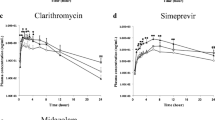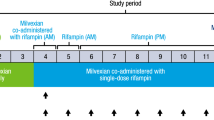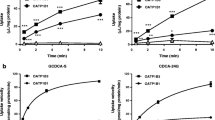Abstract
Purpose
To evaluate association of the dose-dependent effect of rifampicin, an OATP1B inhibitor, on the plasma concentration–time profiles among OATP1B substrates drugs and endogenous substrates.
Methods
Eight healthy volunteers received atorvastatin (1 mg), pitavastatin (0.2 mg), rosuvastatin (0.5 mg), and fluvastatin (2 mg) alone or with rifampicin (300 or 600 mg) in a crossover fashion. The plasma concentrations of these OATP1B probe drugs, total and direct bilirubin, glycochenodeoxycholate-3-sulfate (GCDCA-S), and coproporphyrin I, were determined.
Results
The most striking effect of 600 mg rifampicin was on atorvastatin (6.0-times increase) and GCDCA-S (10-times increase). The AUC0–24h of atorvastatin was reasonably correlated with that of pitavastatin (r2 = 0.73) and with the AUC0–4h of fluvastatin (r2 = 0.62) and sufficiently with the AUC0–24h of rosuvastatin (r2 = 0.32). The AUC0–24h of GCDCA-S was reasonably correlated with those of direct bilirubin (r2 = 0.74) and coproporphyrin I (r2 = 0.80), and sufficiently with that of total bilirubin (r2 = 0.30). The AUC0–24h of GCDCA-S, direct bilirubin, and coproporphyrin I were reasonably correlated with that of atorvastatin (r2 = 0.54–0.70).
Conclusion
These results suggest that direct bilirubin, GCDCA-S, and coproporphyrin I are promising surrogate probes for the quantitative assessment of potential OATP1B-mediated DDI.





Similar content being viewed by others
Change history
21 February 2019
There was a miscalculation of coproporphyrin I AUC0-24h in the published article (Volume 35, Number 7). After the correction of AUC0-24h, AUC ratio and R-square were re-calculated. Then, following corrections were made in the abstract, the body, Fig. 3, Fig. 4 and Table 2 in this article.
Abbreviations
- AUC:
-
Area under the plasma concentration–time curve
- BCRP:
-
Breast cancer resistance protein
- C4:
-
7-hydroxy-4-cholesten-3-one
- CDCA:
-
Chenodeoxycholate
- CDCA-24G:
-
Chenodeoxycholate-24-glucuronide
- CYP:
-
Cytochrome P-450
- DDI:
-
Drug–drug interaction
- GCA:
-
Glycocholate
- GCDCA-S:
-
Glycochenodeoxycholate-3-sulfate
- GDCA:
-
Glycodeoxycholate
- GLCA:
-
Glycolithocholate
- HPLC:
-
High performance liquid chromatography
- LC–MS/MS:
-
Liquid chromatography–tandem mass spectrometry
- MRM:
-
Multiple reaction monitoring
- NTCP:
-
Sodium-taurocholate cotransporting polypeptide
- OAT:
-
Organic anion transporter
- OATP1B1:
-
Organic anion-transporting polypeptide 1B1
- OATP1B3:
-
Organic anion-transporting polypeptide 1B3
- OATP2B1:
-
Organic anion-transporting polypeptide 2B1
- TCDCA:
-
Taurochenodeoxycholate
- TDCA:
-
Taurodeoxycholate
- TUDCA:
-
Tauroursodeoxycholate
- UDCA:
-
Ursodeoxycholate
References
Maeda K. Organic anion transporting polypeptide (OATP)1B1 and OATP1B3 as important regulators of the pharmacokinetics of substrate drugs. Biol Pharm Bull. 2015;38:155–68.
Patel M, Taskar KS, Zamek-Gliszczynski MJ. Importance of Hepatic Transporters in Clinical Disposition of Drugs and Their Metabolites. J Clin Pharmacol. 2016;56(Suppl 7):S23–39.
Lee HH, Ho RH. Interindividual and interethnic variability in drug disposition: polymorphisms in organic anion transporting polypeptide 1B1 (OATP1B1; SLCO1B1). Br J Clin Pharmacol. 2017;83:1176–84.
Yoshida K, Maeda K, Sugiyama Y. Hepatic and intestinal drug transporters: prediction of pharmacokinetic effects caused by drug-drug interactions and genetic polymorphisms. Annu Rev Pharmacol Toxicol. 2013;53:581–612.
Vaidyanathan J, Yoshida K, Arya V, Zhang L. Comparing Various In Vitro Prediction Criteria to Assess the Potential of a New Molecular Entity to Inhibit Organic Anion Transporting Polypeptide 1B1. J Clin Pharmacol. 2016;56(Suppl 7):S59–72.
Shitara Y, Sugiyama Y. Preincubation-dependent and long-lasting inhibition of organic anion transporting polypeptide (OATP) and its impact on drug-drug interactions. Pharmacol Ther. 2017;177:67–80.
Keppler D. The roles of MRP2, MRP3, OATP1B1, and OATP1B3 in conjugated hyperbilirubinemia. Drug Metab Dispos. 2014;42:561–5.
Rodrigues AD, Taskar KS, Kusuhara H, Sugiyama Y. Endogenous Probes for Drug Transporters: Balancing Vision With Reality. Clin Pharmacol Ther. 2017;
Jirsa M., Knisely A.S., Schinkel A., and Kmoch S. Rotor Syndrome. In: R.A. Pagon, M.P. Adam, H.H. Ardinger, S.E. Wallace, A. Amemiya, L.J.H. Bean, T.D. Bird, N. Ledbetter, H.C. Mefford, R.J.H. Smith, and K. Stephens editors. GeneReviews(R), Seattle, 1993.
Tsuruya Y, Kato K, Sano Y, Imamura Y, Maeda K, Kumagai Y, et al. Investigation of Endogenous Compounds Applicable to Drug-Drug Interaction Studies Involving the Renal Organic Anion Transporters, OAT1 and OAT3, in Humans. Drug Metab Dispos. 2016;44:1925–33.
Takehara I, Terashima H, Nakayama T, Yoshikado T, Yoshida M, Furihata K, et al. Investigation of Glycochenodeoxycholate Sulfate and Chenodeoxycholate Glucuronide as Surrogate Endogenous Probes for Drug Interaction Studies of OATP1B1 and OATP1B3 in Healthy Japanese Volunteers. Pharm Res. 2017;34:1601–14.
Thakare R, Gao H, Kosa RE, Bi YA, Varma MVS, Cerny MA, et al. Leveraging of Rifampicin-Dosed Cynomolgus Monkeys to Identify Bile Acid 3-O-Sulfate Conjugates as Potential Novel Biomarkers for Organic Anion-Transporting Polypeptides. Drug Metab Dispos. 2017;45:721–33.
Yee SW, Giacomini MM, Hsueh CH, Weitz D, Liang X, Goswami S, et al. Metabolomic and Genome-wide Association Studies Reveal Potential Endogenous Biomarkers for OATP1B1. Clin Pharmacol Ther. 2016;100:524–36.
Shen H, Chen W, Drexler DM, Mandlekar S, Holenarsipur VK, Shields EE, et al. Comparative Evaluation of Plasma Bile Acids, Dehydroepiandrosterone Sulfate, Hexadecanedioate, and Tetradecanedioate with Coproporphyrins I and III as Markers of OATP Inhibition in Healthy Subjects. Drug Metab Dispos. 2017;45:908–19.
Gilibili RR, Chatterjee S, Bagul P, Mosure KW, Murali BV, Mariappan TT, et al. Coproporphyrin-I: A Fluorescent, Endogenous Optimal Probe Substrate for ABCC2 (MRP2) Suitable for Vesicle-Based MRP2 Inhibition Assay. Drug Metab Dispos. 2017;45:604–11.
Hachad H, Ragueneau-Majlessi I, Levy RH. A useful tool for drug interaction evaluation: the University of Washington Metabolism and transport drug interaction database. Hum Genomics. 2010;5:61–72.
Park JW, Siekmeier R, Lattke P, Merz M, Mix C, Schuler S, et al. Pharmacokinetics and pharmacodynamics of fluvastatin in heart transplant recipients taking cyclosporine A. J Cardiovasc Pharmacol Ther. 2001;6:351–61.
Yoshikado T, Yoshida K, Kotani N, Nakada T, Asaumi R, Toshimoto K, et al. Quantitative analyses of hepatic OATP-mediated interactions between statins and inhibitors using PBPK modeling with a parameter optimization method. Clin Pharmacol Ther. 2016;100:513–23.
Ramanathan R, King-Ahmad AJ, Holliman CL, Rodrigues AD. A highly selective and sensitive LC-MS/HRMS assay for quantifying coproporphyrins as organic anion-transporting peptide biomarkers. Bioanalysis. 2017;9:1787–806.
Lai Y, Mandlekar S, Shen H, Holenarsipur VK, Langish R, Rajanna P, et al. Coproporphyrins in plasma and urine can be appropriate clinical biomarkers to recapitulate drug-drug interactions mediated by organic anion transporting polypeptide inhibition. J Pharmacol Exp Ther. 2016;358:397–404.
Tomita Y, Maeda K, Sugiyama Y. Ethnic variability in the plasma exposures of OATP1B1 substrates such as HMG-CoA reductase inhibitors: a kinetic consideration of its mechanism. Clin Pharmacol Ther. 2013;94:37–51.
Prueksaritanont T, Tatosian DA, Chu X, Railkar R, Evers R, Chavez-Eng C, et al. Validation of a microdose probe drug cocktail for clinical drug interaction assessments for drug transporters and CYP3A. Clin Pharmacol Ther. 2017;101:519–30.
Grube M, Kock K, Oswald S, Draber K, Meissner K, Eckel L, et al. Organic anion transporting polypeptide 2B1 is a high-affinity transporter for atorvastatin and is expressed in the human heart. Clin Pharmacol Ther. 2006;80:607–20.
Noe J, Portmann R, Brun ME, Funk C. Substrate-dependent drug-drug interactions between gemfibrozil, fluvastatin and other organic anion-transporting peptide (OATP) substrates on OATP1B1, OATP2B1, and OATP1B3. Drug Metab Dispos. 2007;35:1308–14.
Shirasaka Y, Suzuki K, Shichiri M, Nakanishi T, Tamai I. Intestinal absorption of HMG-CoA reductase inhibitor pitavastatin mediated by organic anion transporting polypeptide and P-glycoprotein/multidrug resistance 1. Drug Metab Pharmacokinet. 2011;26:171–9.
Choi MK, Shin HJ, Choi YL, Deng JW, Shin JG, Song IS. Differential effect of genetic variants of Na(+)-taurocholate co-transporting polypeptide (NTCP) and organic anion-transporting polypeptide 1B1 (OATP1B1) on the uptake of HMG-CoA reductase inhibitors. Xenobiotica. 2011;41:24–34.
Prueksaritanont T, Chu X, Evers R, Klopfer SO, Caro L, Kothare PA, et al. Pitavastatin is a more sensitive and selective organic anion-transporting polypeptide 1B clinical probe than rosuvastatin. Br J Clin Pharmacol. 2014;78:587–98.
Karlgren M, Vildhede A, Norinder U, Wisniewski JR, Kimoto E, Lai Y, et al. Classification of inhibitors of hepatic organic anion transporting polypeptides (OATPs): influence of protein expression on drug-drug interactions. J Med Chem. 2012;55:4740–63.
McColl KE, Thompson GG, el Omar E, Moore MR, Park BK, Brodie MJ. Effect of rifampicin on haem and bilirubin metabolism in man. Br J Clin Pharmacol. 1987;23:553–9.
Bertolotti M, Del Puppo M, Gabbi C, Corna F, Carulli L, Pellegrini E, et al. Correlation between plasma levels of 7alpha-hydroxy-4-cholesten-3-one and cholesterol 7alpha-hydroxylation rates in vivo in hyperlipidemic patients. Steroids. 2008;73:1197–202.
Galman C, Angelin B, Rudling M. Bile acid synthesis in humans has a rapid diurnal variation that is asynchronous with cholesterol synthesis. Gastroenterology. 2005;129:1445–53.
Chan KM, Scott MG, Wu TW, Clouse RE, Calvin DR, Koenig J, et al. Inaccurate values for direct bilirubin with some commonly used direct bilirubin procedures. Clin Chem. 1985;31:1560–3.
Chu X, Shih SJ, Shaw R, Hentze H, Chan GH, Owens K, et al. Evaluation of cynomolgus monkeys for the identification of endogenous biomarkers for hepatic transporter inhibition and as a translatable model to predict pharmacokinetic interactions with statins in humans. Drug Metab Dispos. 2015;43:851–63.
Suga T, Yamaguchi H, Sato T, Maekawa M, Goto J, Mano N. Preference of conjugated bile acids over unconjugated bile acids as substrates for OATP1B1 and OATP1B3. PLoS One. 2017;12:e0169719.
Blank A, Eidam A, Haag M, Hohmann N, Burhenne J, Schwab M, et al. The NTCP-inhibitor Myrcludex B: effects on bile acid disposition and Tenofovir pharmacokinetics. Clin Pharmacol Ther. 2017.
Andreev E, Koopman M, Arisz L. A rise in plasma creatinine that is not a sign of renal failure: which drugs can be responsible? J Intern Med. 1999;246:247–52.
Imamura Y, Murayama N, Okudaira N, Kurihara A, Okazaki O, Izumi T, et al. Prediction of fluoroquinolone-induced elevation in serum creatinine levels: a case of drug-endogenous substance interaction involving the inhibition of renal secretion. Clin Pharmacol Ther. 2011;89:81–8.
Fromm MF. Prediction of transporter-mediated drug-drug interactions using endogenous compounds. Clin Pharmacol Ther. 2012;92:546–8.
Chu X, Bleasby K, Chan GH, Nunes I, Evers R. Transporters affecting biochemical test results: creatinine-drug interactions. Clin Pharmacol Ther. 2016;100:437–40.
Ito S, Kusuhara H, Kumagai Y, Moriyama Y, Inoue K, Kondo T, et al. N-methylnicotinamide is an endogenous probe for evaluation of drug-drug interactions involving multidrug and toxin extrusions (MATE1 and MATE2-K). Clin Pharmacol Ther. 2012;92:635–41.
Acknowledgments and Disclosures
The authors thank Miwa Yoshida (P-One Clinic) for her technical support in conducting the clinical research, and Drs. Ragu Ramanathan, Amanda King-Ahmad, and David Rodrigues (Pfizer, Groton, CT) for their kind support in introducing their analytical method for coproporphyrins I and III to this study. This study was financially supported by a Grant-in-Aid for Scientific Research (S) [Grant 24,229,002], and Grant-in-Aid for Scientific Research (B) [17H04100] from Japan Society for the Promotion of Science, and a Grant-in-Aid from the Japan Research Foundation for Clinical Pharmacology.
Author information
Authors and Affiliations
Corresponding author
Rights and permissions
About this article
Cite this article
Takehara, I., Yoshikado, T., Ishigame, K. et al. Comparative Study of the Dose-Dependence of OATP1B Inhibition by Rifampicin Using Probe Drugs and Endogenous Substrates in Healthy Volunteers. Pharm Res 35, 138 (2018). https://doi.org/10.1007/s11095-018-2416-3
Received:
Accepted:
Published:
DOI: https://doi.org/10.1007/s11095-018-2416-3




